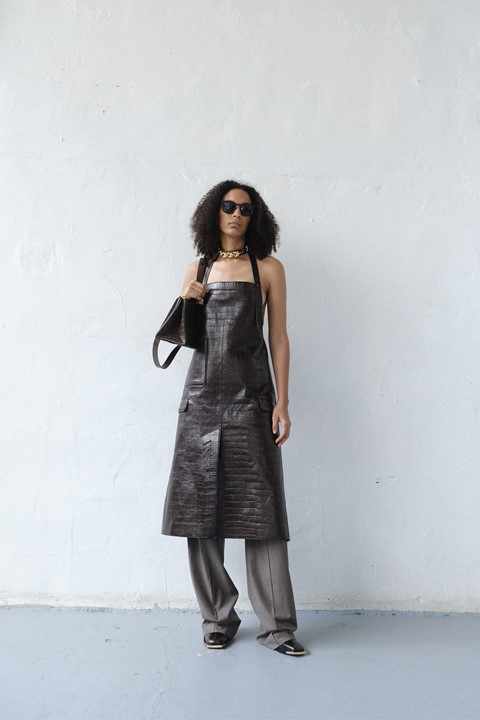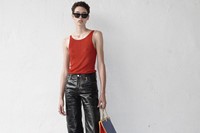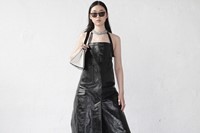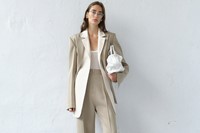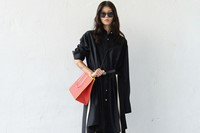As New York-based designer Peter Do releases his Spring/Summer collection film, he talks to Hannah Tindle about the evolution of his brand and designing in the age of Covid-19
Over two years ago, AnOther interviewed New York-based designer Peter Do and two members of his team, Vincent Ho and Jessica Wu. At the time, they were a small group of friends collaborating under Do’s namesake, having founded the label just months earlier. Although in its infancy, the brand was instantly recognisable for its uber-clean silhouettes and superb tailoring with a whimsical twist – Do worked at Céline under Phoebe Philo, which would explain why there is always a little more to the label’s grown-up aesthetic than meets the eye.
In 2020, Peter Do was a co-recipient of the LVMH prize and has been nominated for the Emerging Designer of the Year award by the CFDA. Having just launched its Spring/Summer 2021 collection film, which plays upon the idea of ‘upside down and inside out’, we caught up with Do to find out how the brand has evolved since we last spoke, and explore how he and his design ‘family’ are navigating the fashion industry against the backdrop of Covid-19 and political unrest in America.
Hannah Tindle: We last spoke in 2018 when the Peter Do brand was relatively new. Can you tell us how it has evolved since then?
Peter Do: When we first spoke, we were really figuring things out as we went. Peter Do is now two years old and we’ve grown to a family of 12, which we’ve managed to keep together. We’ve had to cap our wholesale partners to 40 to preserve our production quality. We’re doing our own thing, creating our own rules, and keeping our independence. We feel like outsiders in many ways. Two years in, we’ve tried to create an internal culture based on kindness and mutual respect, which still strangely seems rare in fashion. But it’s the heart of what we do. No matter how big we get, we will always put family first.
HT: What new design concepts have you introduced since 2018?
PD: We always make only what’s necessary and what we like, so it’s more about adapting, testing and reducing everything we make to what we really love and to what feels vital. We always ask: How can we make something we’ve done before better? There are some pieces from the first season that we continue to build on. For example, the four-piece suit is reimagined to adapt to how we are feeling that season. Same with our Spacer fabric, which has become a Peter Do signature: we revisit, revise and refine each season. We only create two collections a year, so we have time to reflect on how we work. It takes a year to flesh out ideas to understand them fully. We’ve also made moves to grow our accessories: for fall we introduced shoes. They borrow from the boys; they’re substantial and they keep you grounded. We’re excited to debut our first bag collaboration for Spring with Medea, by the Italian twins Camilla and Giulia Venturini. We met them in Paris during showrooms and I really liked how simple and functional the designs are.

HT: What are some of the stand out moments for you and the brand from over the past two years?
PD: There was a moment about a year ago when I think all of us at Peter Do felt a subtle change … We gained confidence and we weren’t scrambling as much as we did when we first started. In the beginning, we were just five friends working out of my apartment in Brooklyn. We would meet at nights and on weekends because we all had a day job. Sometimes it still feels that way. Even though it might not seem like it from the outside, it’s taken us a long time to get to where we are at today. We were co-winners of the LVMH Prize this year and then recently we were nominated for the CFDA as Emerging Designer; to be recognised by these bodies is really appreciated.
HT: Can you talk through your latest collection and video for S/S21? How did you devise the concept?
PD: We started designing the collection in February. But the pandemic and societal changes shifted our thinking. Pre-pandemic, we wanted to focus on the idea of comfort, of slowing down. S/S21 breaks from the contentment of comfort to strike new ground and acknowledges what today feels like: upside down, inside out, broken rules. The collection feels fragmented to reflect the current state of the world and is a result of us breaking our own rules. We turned to softer fabrics for everything, including tailoring. A/W20 was about the ‘final girl’ in horror movies – the girl who makes it to the end, stronger than ever. The tailoring was really hard-edged and with sharp silhouettes to convey that powerful strength. But over the course of the year, we started to ask: How can we express strength in another way? Garments are cut and chopped, twisted and wrapped for the wearer to experiment with. Yet, the stainless steel plates still represent these harder facades that act as a layer of protection. Without the in-person factor, we wanted to find a way to show how the clothes move.

HT: What are some of the particular garments from the collection that exemplify the season?
PD: The cape top is based on a dress that we did in our first season. We slashed the front and now you can drape it over your shoulders and knot it. Or, you can wrap it around your waist to create a more fitted top. There’s no closure, which gives you the idea that there are no rules. Removing it really leaves the piece up for interpretation and piques curiosity. There’s no ‘right’ way to wear it.
The first ‘apron look’ is actually designed after my own apron that I wear at home to cook. It’s a vintage apron from the 1940s that I found in Dumbo. At the start of the New York lockdown I was cooking a lot, which is my parallel practice to design; I was dreaming of being outside. So I wanted to design an apron with this croc-embossed leather material to make it feel like there’s a sense of dressing up. Going outside during the pandemic felt like the ultimate luxury. I think the collection video we created speaks to this nostalgia for dressing up and going outside. Like the clothes, the music was very fragmented. It was a compilation of sounds and noise that you’d hear on a busy street in New York City.
HT: How have things changed for you, your brand, and the way you work since Covid-19?
PD: During lockdown, we had to adjust our way of working and adapt. So much of how we design was based on our in-person conversations together, our weekly fittings and actually touching the fabric in real life. It was really tricky to design via Zoom. I’ve learned that it’s very difficult to describe how a fabric feels to the touch. At one point when things started to open up, I would go to the studio alone to touch the fabrics and make fitting marks on toiles. I really missed the tactile design process. As soon as the team slowly came back together in the studio, that’s when the collection took on a new shape and took on new energy and direction. We were just really happy to see each other again and to do what we love.
HT: When it comes to the future, what are you most excited about?
PD: I think the past few months have really challenged the fashion industry: from Covid-19 to the Black Lives Matter protests. Racism against Asian communities and economic inequality have been heightened by the virus; acts of police brutality against Black people and protestors were happening right in front of us. We felt that we needed to stand up and speak out as a collective. The majority of the Peter Do team are immigrants, and by way of our own experiences, we have always been responsive to what is happening socially and politically. But this is the first time that we opened up our brand channel to vocalise and take part in political and community action. We still feel an attack against one is an attack against all.
In the past few months, we began working on fundraising initiatives with a number of non-profit organisations in and around New York City such as Heart of Dinner, APICHA (a community health centre in NYC), The Okra Project and more. As a brand, we’ve made a pledge to work more closely with our communities, especially during these times, and to help in whatever way we can. I hope that not only as individuals but as an industry, we can continue to use the tools we have to create change.
